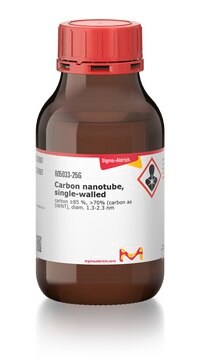755710
Carbon nanotube, single-walled
>70% (TGA), avg. no. of layers, 1
Synonym(s):
NC-1100, SWCNT, SWNT, Single wall carbon nanotube
About This Item
Recommended Products
Quality Level
assay
>70% (TGA)
form
powder
feature
avg. no. of layers 1
manufacturer/tradename
Nanocyl, Inc.
size × L
× 3 μm , TEM
average diameter
2 nm
mp
3652-3697 °C (lit.)
density
1.7-1.9 g/cm3 at 25 °C (lit.)
SMILES string
[C]
Looking for similar products? Visit Product Comparison Guide
Related Categories
General description
Application
Preparation Note
Legal Information
Storage Class
11 - Combustible Solids
wgk_germany
WGK 3
flash_point_f
Not applicable
flash_point_c
Not applicable
Choose from one of the most recent versions:
Already Own This Product?
Find documentation for the products that you have recently purchased in the Document Library.
Customers Also Viewed
Articles
Single-Walled Carbon Nanotubes synthesized by the Super-Growth Method & their properties & applications, including dispersing SGCNTs, SGCNT-polymer composites & SGCNT-metal composites are discussed.
3D printing is a type of additive manufacturing that can be used to rapidly fabricate components with highly customizable geometries.
Carbon nanomaterials (CNMs), such as single-walled carbon nanotubes (SWCNTs), multi-walled carbon nanotubes (MWCNTs), and graphene (Figure 1), have diverse commercial applications including lighter and stronger composite materials, improved energy storage devices, more sensitive sensors, and smaller transistors.
Boron nitride nanotubes (BNNT) are close structural analogs of carbon nanotubes (CNT), which are high aspect ratio nanotubular material, where carbon atoms are alternately substituted by nitrogen and boron atoms.
Our team of scientists has experience in all areas of research including Life Science, Material Science, Chemical Synthesis, Chromatography, Analytical and many others.
Contact Technical Service



